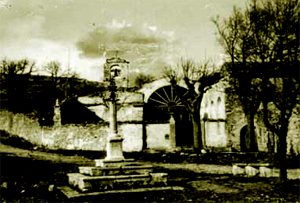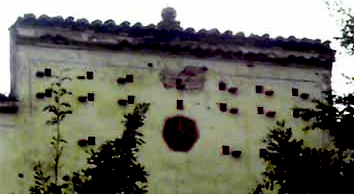The male monastieriesby Vincenzo Falasca
Convent of St. JulianSt. Julian was one of many monasteries founded by the monks, followers of St. Basil, in Basilicata. We don’t have any traces about St. Julian’s convent and the small church attached. It was built in the late fifth century in Rungi district, in a place called St. Mary of the Stone. The small church had already been built before (around 550) by Grumentum’s Bishop Julian, and from him took the name the whole structure of the convent. Between 950 and 960 the monk Luca from Demennea (Messina) landed in Agri Valley re-establishing and restoring the convent, at that time in ruins. Then he moved to Armento. Before the sixteenth century it was suppressed and its properties passed first to the Archbishop Holy Communion of St. Mary in Nazareth, then to Barletta and finally to the Collegiate of Saponaria.
Convent of St. Anthony Abbot
It is saved just the church, renovated in various eras, while there are very little remains of the monastery structure. Among them there is a circular compartment, resting on a living notched rock probably used for storing oil, wine and foodstuff.
Franciscan convent of monastery OrderIt was built in the place where now exists the city cemetery. Caputi says:”…remained at cemetery since 1841 at a cost of nine hundred ducats”. It was surely one of the oldest Franciscan settlements in Basilicata. By tradition it was founded directly by St. Francis after his return from Africa. It is saved just the chapel room of Sanseverino, used for long time as ossuary. It was the richest convent of all Saponaria.
Franciscan convent of Minors Capuchin FriarsIt was founded in 1555, at the request of University, in the south-east position of the town, in a place where there was already the small church of St. James and St. Philip Apostles.
In May 1714 here there was the Council of Capuchin Chapter Padres of Basilicata Province, for the election of Major Superiors. In 1737 the small monastic library was enriched with precious books, donated by the archpriest-archaeologist Carlo Danio with the obligation to grant the access also to the laics. In 1734 the monastic Province of Basilicata was divided in three Custodies and at the head of one of them, the Marine one, was placed the convent of Saponara. By the act of 7th July 1866, n°3036, after its partial destruction because of the earthquake in 1857, it was suppressed. Only on 25th November 1957, exactly a year after the earthquake, Capuchins Friars come back in Grumento, in the persons of Father Ludovico from Serino (Guardiano) and Father Leonardo.
Monastic St. Lawrence Grange from Padula
They had a detached seat in Spineta district and a “mill, commonly called twirl, under St. Lucy”. In the I.G.M. table comprising Spineta district, we found marked a wide wood called “Wood of St. Lawrence”. |




 Very ancient monastery, contemporary or even earlier compared to that one of St. Julian. It was founded in the Homonym district by St. Anthony’s followers friars, who built the noblest nucleus of Oriental monasticism.
Very ancient monastery, contemporary or even earlier compared to that one of St. Julian. It was founded in the Homonym district by St. Anthony’s followers friars, who built the noblest nucleus of Oriental monasticism. At its birth, it was included in the monastic Province of St. Jerome, that embraced Puglia and Basilicata. On 9th August 1560 it moved to the new Province of Basilicata.
At its birth, it was included in the monastic Province of St. Jerome, that embraced Puglia and Basilicata. On 9th August 1560 it moved to the new Province of Basilicata. Presumably in the early 1600s (we don’t have reliable dates about that) was founded in Saponaria by Carthusian monks from
Presumably in the early 1600s (we don’t have reliable dates about that) was founded in Saponaria by Carthusian monks from